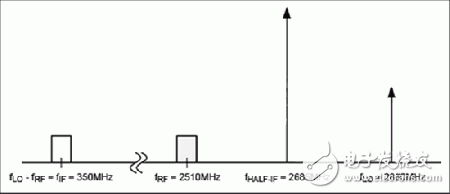This article explores the challenges of meeting the high-performance requirements for a base station (BTS) receiver, particularly in managing half-IF spurs. To achieve this, engineers must understand the relationship between a mixer's IP2 and its second-order response, then choose an RF mixer that meets the system’s cascading requirements. Mixer data sheets often present second-order performance in terms of the second-order intercept point (IP2) or a 2x2 spurious suppression indicator. This paper explains how to design a receiver and determine overall half-IF spurs by analyzing these two parameters, using the MAX19997A as a practical example—an active mixer designed for E-UTRA LTE receivers.
Mixer Harmonics
In a superheterodyne receiver, the mixer downconverts the high-frequency RF signal to a lower intermediate frequency (IF). This process is known as downconversion. Depending on whether the local oscillator (LO) frequency is lower or higher than the RF frequency, it is referred to as low-side or high-side injection, respectively. The downconversion can be expressed mathematically as:
fIF = fRF - fLO = -fRF + fLO
Where fIF is the IF output from the mixer, fRF is the RF input, and fLO is the LO input. Ideally, the mixer output is linear with respect to the RF input and independent of the LO amplitude. However, due to the nonlinear behavior of mixers, unwanted mixing products—known as spurious responses—are generated. These spurious signals are caused by interference or noise at the RF input and can fall into the IF band, causing distortion and degrading receiver performance.
The general mixing principle can be represented as:
fIF = m fRF - n fLO = -m fRF + n fLO
Here, m and n are integers representing subharmonics of the RF and LO frequencies. As m or n increases, the magnitude of the spurious components generally decreases. Careful frequency planning is essential to minimize such interferences, especially in wideband systems where out-of-band signals may fall into the IF band. Filtering before and after the mixer helps suppress these unwanted signals, ensuring clean IF output.
Balanced mixers, especially double-balanced ones, are effective at rejecting even-order harmonics, improving linearity and reducing the need for additional filtering. They also provide isolation between the RF, IF, and LO ports, minimizing leakage and enhancing overall performance.
Half-IF Spurious Frequency Distribution
One of the most challenging spurious signals is the second-order spurious response, commonly referred to as the half-IF spur. It occurs when m = 2 and n = -2 (low-side injection) or m = -2 and n = 2 (high-side injection). For example, if the desired RF center frequency is 2510 MHz (E-UTRA uplink channel 39790), and the LO is set to 2860 MHz, the IF is 350 MHz. A blocking signal at 2685 MHz will produce a half-IF spur at 350 MHz.
In high-side injection, the blocking frequency is fIF/2 above the required RF frequency. In low-side injection, it is fIF/2 above the LO frequency. This relationship is critical in designing receivers that can handle strong interfering signals without compromising the integrity of the desired IF signal.

Figure 1: E-UTRA high-side LO injection example showing the required fRF, fLO, fIF, and undesired fHALF-IF frequency distribution.
Assumption:
â— fRF center frequency = 2510 MHz
â— fLO = 2860 MHz
â— fIF = fLO - fRF = 350 MHz
Calculate the blocking frequency that causes the half-IF spur:
fHALF-IF = fRF + fIF/2 = 2685 MHz
Verification of the half-IF spurious frequency:
2 × fLO - 2 × fHALF-IF = 2 × (fRF + fIF) - 2 × (fRF + fIF/2) = fIF
Thus, 2 × 2860 MHz - 2 × 2685 MHz = 350 MHz, confirming the presence of a half-IF spur.
Receiver IP2
If a device’s data sheet does not directly specify the 2x2 spurious response, it can be derived from the IP2 value. Assuming only the fundamental components are applied to the mixer, and that harmonic distortion comes solely from the mixer itself, the IP2 provides insight into the second-order distortion characteristics. Strong input signals can lead to intermodulation products, which are quantified using the IP2 metric. For instance, a 2nd order IM product increases by 2 dB for every 1 dB increase in input level due to the squared relationship.
Half-IF Spurious Power Level
Using the MAX19997A downconverting mixer as an example, the following specifications are provided in its AC electrical data sheet:
â— RF spurious power = -5 dBm (at 2685 MHz)
â— LO level = +0 dBm (at 2860 MHz)
The typical 2LO - 2RF spurious response is 64 dB below the RF carrier level, corresponding to an IMR2 of 64 dBc. Using this, the spurious power level (PSPUR) can be calculated as:
PSPUR = -5 dBm + (-64 dBc) = -69 dBm
The MAX19997A’s excellent 2x2 performance translates to an equivalent IIP2 of +59 dBm at its input, calculated as:
IIP2 = 2 × IMR2 + PSPUR = 64 dBc + (-5 dBm) = +59 dBm
Similarly, the MAX19985A 900 MHz active mixer offers a 2RF - 2LO spurious response of 71 dBc under similar conditions, resulting in an IIP2 of +66 dBm.
These examples highlight the importance of selecting mixers with strong second-order performance to mitigate half-IF spurs and ensure reliable receiver operation in high-performance communication systems like E-UTRA LTE.
Kevlar Woven Net Pipe,Kevlar Braided Protective Tube,Kevlar Braided Sleeve
Shenzhen Huiyunhai Tech.Co., Ltd. , https://www.cablesleevefactory.com